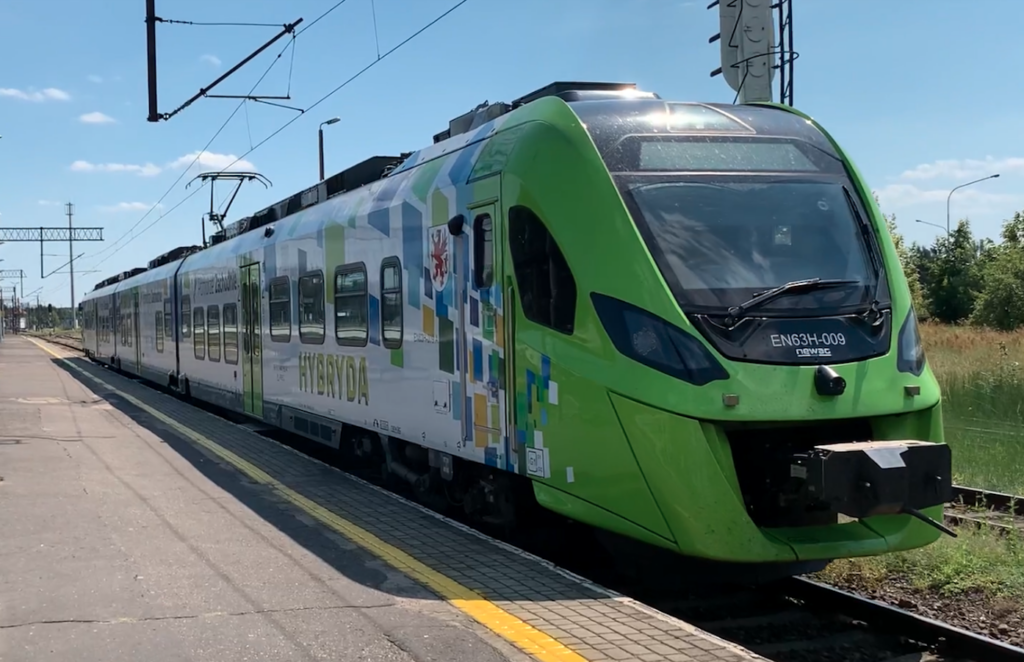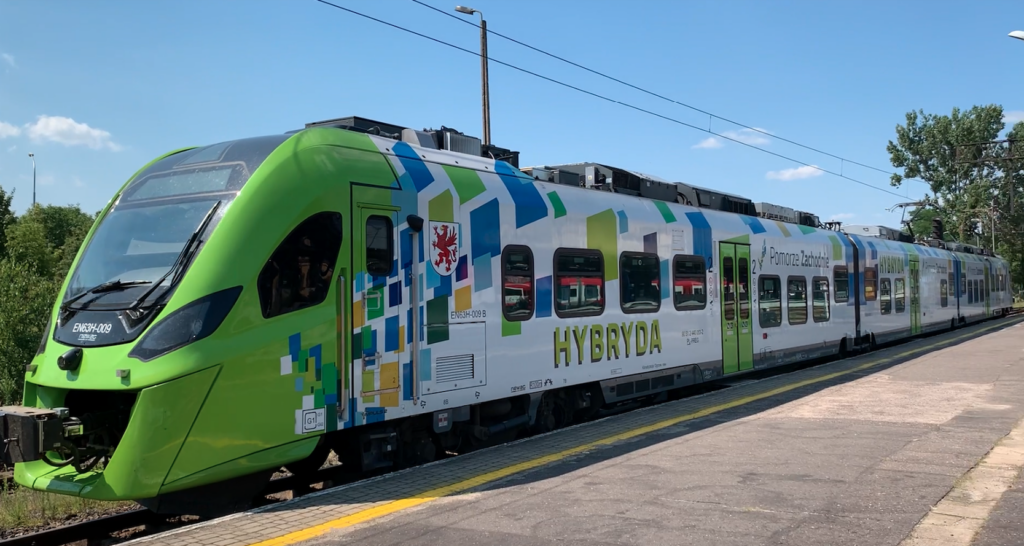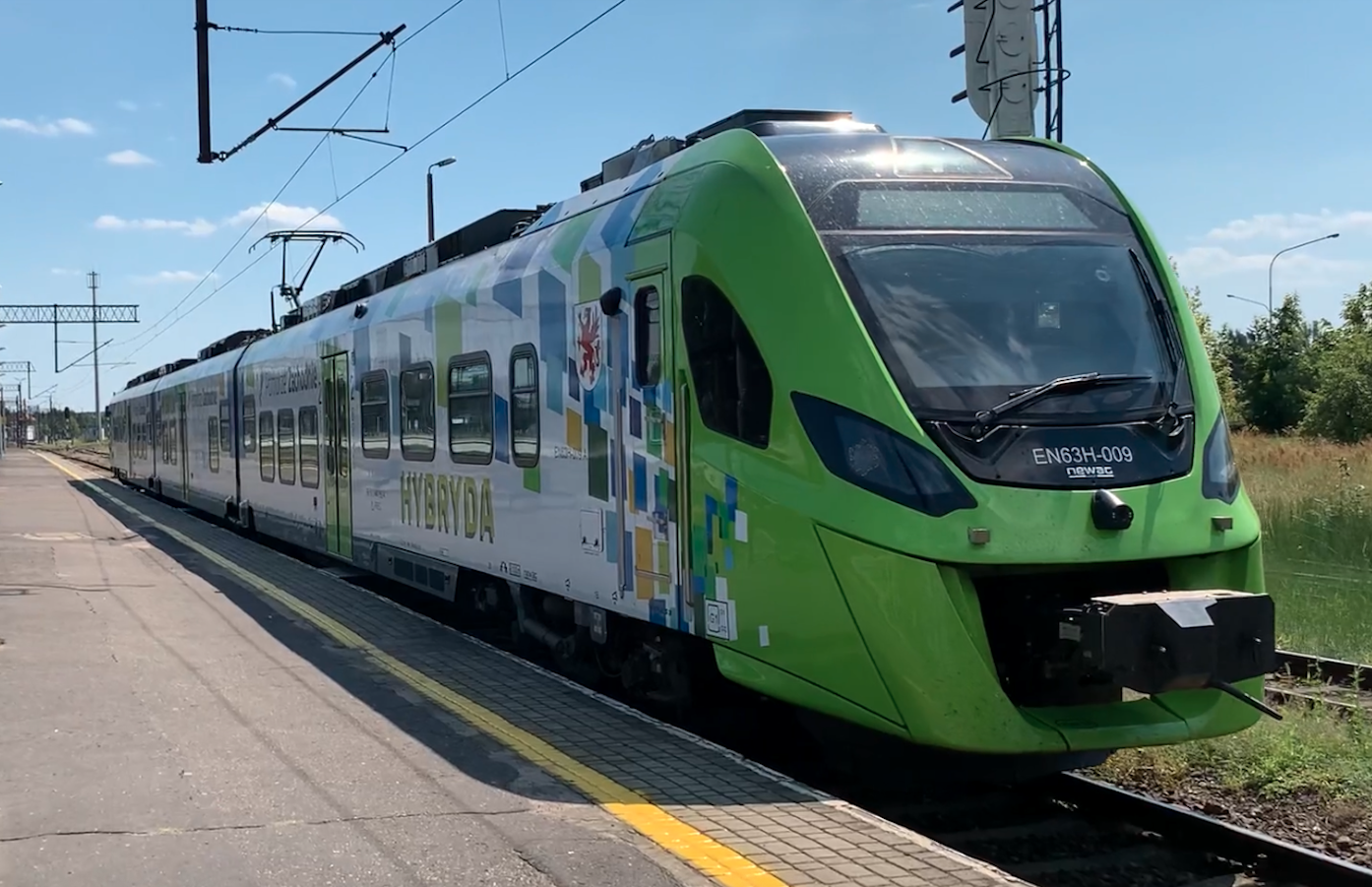Kraków 2025-07-25
Polish dual-traction locomotives.


As of December 31, 2022, Poland had approximately 21,550 km of railway lines, including standard gauge (1435 mm) and broad gauge (1520 mm) tracks. 19,393 km of lines were in active operation. The remaining lines and main sidings are unused or technically inoperable.
About 12,236 km of railway lines are electrified in Poland, representing approximately 62.5% of all lines in operation (or approximately 19,576 km), according to data from 2023. Current electrification primarily involves installing new traction on revitalized stations and lines that were already electrified. In 2024, PKP PLK commissioned 131 km of electrified tracks.
The plans were established for the period 2025–2029. PKP PLK plans to conclude contracts worth PLN 15 billion annually. By the end of 2025, it is estimated that 494 km of electrified railway lines will have been completed, primarily through modernization and renovation projects. The amendment to the National Railway Program includes the electrification of over 1,000 km of additional lines, particularly local ones, which seems unrealistic in the current situation.
The following investments are planned and underway: Railway Line No. 104 Chabówka – Nowy Sącz (implementation period 2022–2027); Railway Line No. 181 Kępno – Oleśnica (implementation period 2024–2026). LK No. 201, 214, 229 Kościerzyna – Gdynia – Somonino (implementation period 2024-2030). LK No. 24 Piotrków Trybunalski – Bełchatów (implementation period 2023-2029). LK No. 30 Łuków – Lublin (implementation period 2026-2029). LK No. 55 Siedlce – Sokołów Podlaski (implementation period 2025-2030). LK No. 38 Korsze – Ełk (first electrification, implementation period 2022-2026). LK No. 203 Gorzów–Kostrzyn (electrification has been planned for many years. The Germans are pushing for electrification with 15 kV alternating current with a frequency of 16 2/3 Hz).
In 2025, the anti-Polish government (Folksdeutsche, communists, and Freemasons) was celebrating the electrification of over 1,000 kilometers of railway lines within three years. Their slogan was: “What harm can it do to promise?” The amendment to the National Railway Program was to include a project to electrify over 1,000 kilometers of railway lines. The final list was unknown, but PKP PLK (Polish State Railways) indicated the need to electrify the following railway lines: to Łomża, the section from Płock to Laskowice Pomorskie via Grudziądz, the Sub-Sudecka Main Line, and from Szamotuły via Międzychód and Gorzów to Szczecin. The problem was this: the European communist party had conceived of a complete abandonment of diesel rolling stock. It stopped supporting new diesel locomotive programs with grants and pursued a fictitious green energy strategy. True, it was; The backward German electric car industry and the collapse of Volkswagen caused a temporary setback among the corrupt elites ruling the European Union.
Against this backdrop, the Polish rail vehicle industry appears modern and realistic in its approach to the situation on our tracks.
The Impuls 2 Hybrid Multiple Unit, type 36WEh.
The Impuls 2 Hybrid Multiple Unit, type 36WEh, is the first Polish passenger train that, in addition to an electric drive powered by a 3 kV DC overhead contact line, also features a diesel drive, in the form of an MTU PowerPack system. This system allows the train to operate on routes without electric traction.
The HZT Impuls 2 series train, type 36WEh, was built in Nowy Sącz in secret and entirely developed by Polish engineers and technicians. The vehicle is not only innovative but above all practical and fits perfectly into the Polish railway network. As of December 31, 2018, the length of operational railway lines in Poland was 19,200 km, including 11,900 km electrified. During the communist era, there were plans to electrify the entire railway network. However, the communist-era economy, mismanaged by the communists, was unable to implement this plan. The HZT Impuls 2 type 36WEh vehicle featured innovative technologies that were successfully combined into a seamlessly functioning system.
In 2019, the vehicle was officially unveiled at the 13th TRAKO 2019 International Trade Fair in Gdańsk. During this fair, NEWAG S.A. received the main prize in the prestigious competition named after engineer Ernest Malinowski for products and technical innovations used in the railway industry. The Impuls 2 type 36WEh Hybrid Multiple Unit received an award in the competition.
The HZT NEWAG IMPULS 2 type 36WEh is the newest and most modern multiple unit in the world, already operated by several regional railways in Poland. This vehicle has prevented the emergence of further gaps in the Polish Railway Network, which excluded a significant portion of Polish society from access to this mode of transport. The first vehicles of this type were purchased by the West Pomeranian Voivodeship, Lower Silesian Voivodeship, Łódź Voivodeship, and Greater Poland Voivodeship.
The HZT NEWAG IMPULS 2 type 36WEh is a three-carriage train that, under electric traction, travels at a speed of 160 km/h, and thanks to its combustion engines, travels at 120 km/h on unconstrained tracks. These parameters perfectly match the requirements of Polish railways. The train carries 330 passengers and, importantly, is accessible to people with limited mobility. Passengers have access to: Wi-Fi, 230 V AC power outlets, USB ports, air conditioning, a bicycle storage area, a modern passenger information system, window tables, luggage racks, and closed-circuit toilets.
Pesa Gama Electric-Diesel Locomotives.
The Pesa Gama locomotive is a family of electric and diesel locomotives built since 2012 by the Pesa Bydgoszcz plant in Poland. The locomotives are built as diesel, electric, and diesel-electric locomotives. By 2022, a total of over 50 locomotives had been built in three versions: diesel, electric, and hybrid, meaning they can be powered by the mains or run on a generator. The locomotives are operated by companies such as PKP InterCity, Koleje Mazowieckie, and Pol-Miedź Trans.
The Pesa Gama locomotive has evolved into an entire family of traction vehicles. The locomotive was developed as part of the project “Universal, multi-system electric locomotive with a modular design, for speeds exceeding 200 km/h.” The first model in the Gama family is the 111Ed locomotive with an additional diesel engine, or rather a generator. The locomotive was unveiled at the InnoTrans trade fair in Berlin on September 18, 2012. Testing began in October 2012. The tests were extensive. On December 3, 2012, the locomotive reached a speed of 173 km/h. The locomotive received a temporary certificate for passenger train service at speeds of up to 160 km/h and freight trains at 140 km/h. In January 2013, the 111Ed Marathon locomotive began regular service with Lotos Kolej freight trains. In February 2013, the locomotives began operating on PKP IntrCity. The locomotives have never experienced a single defect, and the list of minor faults did not affect safety. In March 2014, 111Ed Marathon locomotives were tested by other users: Pol-Miedź Trans and Orlen KolTrans.
On July 10, 2014, the Office of Rail Transport issued a permanent certificate of acceptance for operation for the type 111Ed locomotive. On April 15, 2014, a contract was signed for the delivery of two type 111Eb locomotives for Koleje Mazowieckie. On July 8, 2015, the first Gama locomotive was purchased by Lokomotiv, a Polish private rail operator, and the operator simultaneously ordered two additional locomotives. As of January 2021, Pesa Bydgoszcz has produced 33 locomotives: 22 electric and 11 diesel.
The 111Eb/Ec locomotive is versatile and suitable for passenger and freight trains. Type 111Eb: Length 19.80 m, Width 3.00 m, Height 4.15 m, Weight 84,000 kg. Maximum axle load: 206 kN. Wheel diameter: 1.25 m. Maximum speed: 140-160 km/h. Maximum power: 5,600 kW. Power supply: 3 kV DC.
The Type 111Ec is a locomotive designated as an Electric / Last-Mile Diesel. This means that its primary operation is on 3 kV DC electric traction. The diesel generator is used for shunting on sidings without wires. It allows the entire hauled train to be moved. Engine type: most commonly a Caterpillar C15 ACERT – a 6-cylinder V-diesel engine. Power: approximately 403 kW (approx. 420 kVA EMIT generator). Range: minimum ~42 km on the internal combustion engine, consistent with the “Marathon” name. Fuel: diesel, 900-liter tank. Diesel driving speed: standard up to 40 km/h, during testing: up to 76 km/h (without carriages). Conversion from electric to diesel takes approximately 5 minutes.
Newag Dragon locomotive with additional generator.
Newag Dragon is a family of six-axle electric locomotives designed to pull heavy freight trains weighing up to 4,500 tons. Dragon, or “Smok,” is the popular trade name for this locomotive. Dragon represents a new standard among freight locomotives, particularly suited to Polish conditions. The E6ACT Dragon locomotive also bears the PKP ET25 series designation and is the first new Polish freight locomotive, following the ET22, whose production ended in 1989. Dragon is characterized by high tractive effort of up to 374 kN, operational safety, attractive pricing, economical operation, extensive equipment, and reliability.
The first Dragon locomotive was built in 2009 at ZNLE Gliwice. The Electric Locomotive Repair Plant was built in cooperation with NEWAG, based in Nowy Sącz. The Newag Dragon locomotive was manufactured by NEWAG Gliwice from 2009 to 2016, and by Newag Nowy Sącz from 2017 onwards. By 2021, a total of over 50 locomotives in various versions had been produced and are operated by Polish freight carriers.
The Newag Dragon locomotive (E6ACT / Dragon 2 series) in variants with the “Last‑Mile Diesel” function has an additional diesel engine for running on non-electrified sections of the route, such as sidings or terminals. The diesel engine in the Dual Power variant (E6ACTd / Dragon 2 DP): Unit power: approximately 520 kW (~697 HP). Generator type: diesel engine with generator (“Last-Mile” module) – for example, for Dragon 2: Cummins X15-L675, meeting the StageV emissions standard, fuel tank capacity ~1410 liters. Driving range on diesel: up to approximately 150 km with a full train; maximum speed on diesel power tested up to 130 km/h. Starting tractive effort: in the maneuvering range up to ~20 km/h. The locomotive can pull a heavy train (~4000 tons) with the diesel engine alone.
Pesa Gama Dual Power, type 111DE.
The Pesa Gama Dual Power locomotive, also known as type 111DE, is a dual-drive (bi-mode) model developed jointly by PESA and PKP InterCity. The locomotive combines an electric drive with a combustion engine: the Cummins QSK60 combustion engine, meeting the Stage V emission standard. Unit power: approximately 2013 kW (~2700 hp), with up to 1560 kW transmitted to the drive axles. Electric power: approximately 2800 kW on a 3kV DC network, with a maximum speed of 160 km/h. Maximum speed in diesel mode: up to 120 km/h (official limit). In practice, the locomotive can run faster, but only in testing. Vehicle weight: approximately 87.5 tons, axle load ~22 tons, with a special bogie suspension solution.
The prototype of version 111DE-001 has completed tests on the Railway Institute track in Żmigród (summer 2024). This vehicle is the first dual-traction PESA locomotive of this type. PKP Intercity has ordered 16 Dual Mode locomotives, which will be delivered between 2025 and 2026. The first unit is scheduled for supervised operation by September 2025. The new version also features a refreshed appearance and modern interior architecture, inspired by RegioFox designs, among others.
Written by Karol Placha Hetman
